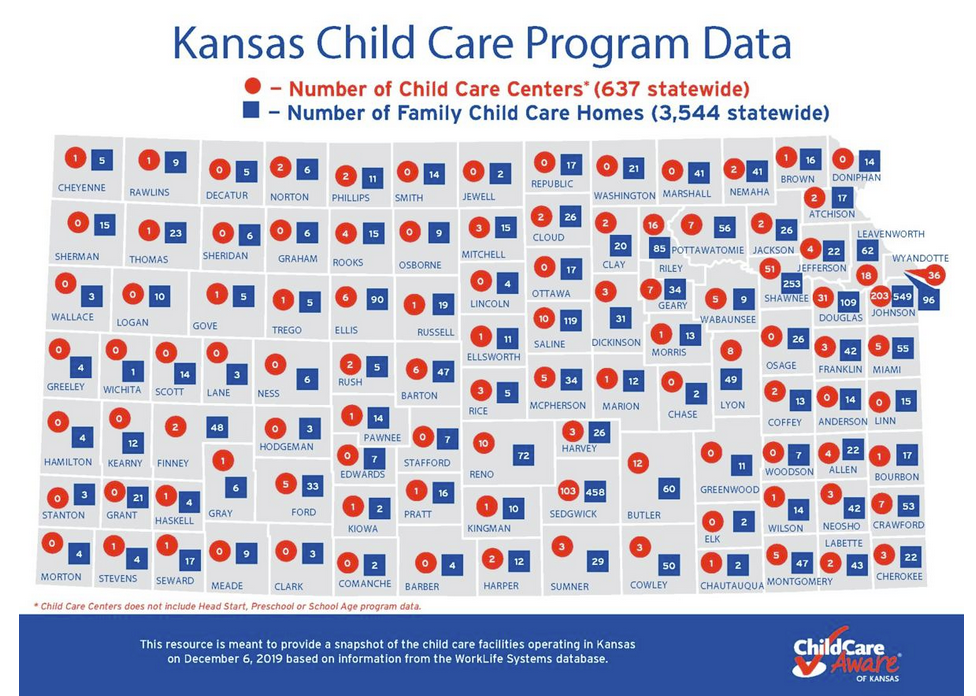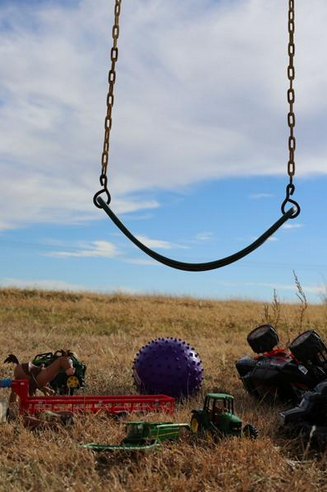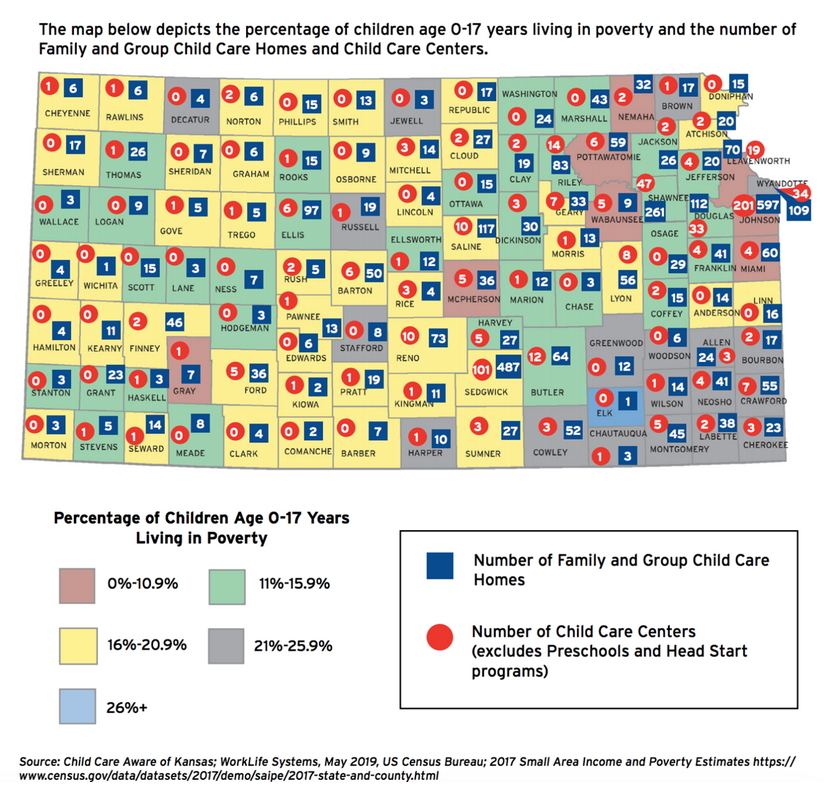
Who’s watching the kids?
By JENNIFER M. LATZKE
High Plains Journal
Economic development directors and community leaders have raised the alarm for years about a checklist of infrastructure improvements that will drive business development in rural areas. Topics such as reliable high-speed internet access; affordable and quality housing; healthy public school systems and available health care are the keys to thriving communities. These, they say, will attract job hunters looking for a slice of small-town life to raise families and grow towns. But there’s one item on the checklist that’s been overlooked for far too long.
Who’s watching the kids while their parents are at their rural jobs?
Availability
It’s a simple question, but for Simone Elder, answering it causes her to pause. Finding regular child care for her infant daughter, Juliette, in Leoti, Kansas, in rural Wichita County, has been a challenge. With just one state licensed provider in the county, who doesn’t take infants, Simone and her husband, Levi, have had to rely on a network of family and friends to help care for their daughter while both work in town.
“We wanted kids so bad,” she said. “It took us five years to get our daughter. And when I found out I was pregnant I started praying that I could find someone to watch her when I went back to work. All nine months I searched. And she’s 3 months old and we’re still searching.”
In 2017, Kansas parents like the Elders welcomed 36,464 new babies into their families, according to the Kansas Department for Children and Families and Child Care Aware of Kansas, the administrator of the statewide Child Care Resource and Referral network in the state. The agencies release supply and demand data annually for child care in the state.
They survey four general types of child care providers. There are individual and group home providers, where a maximum of 10 to 12 children under 16 years of age are taken care of in a provider’s private home. Then there are child care centers, which are roughly defined as a separate facility where care and educational activities are provided for 13 or more children. And finally, there are preschools, Kansas Head Start and Early Head Start programs, which provide care and learning experiences for toddlers up to kindergarten-age children and service low-income children and their families.
Their 2019 report showed that there are 18 counties in Kansas that do not have openings for infants and toddlers in licensed facilities, and Wichita County is on that list. The same report stated that statewide communities lost 501 home child care providers since 2016. And while child care centers are increasing in number, there are still 38% of Kansas counties that do not have child care centers in their community. In those communities the need is filled by home providers, many of whom are nearing retirement age, according to many experts in the field.
“In 77% of Kansas counties, there are more than 10 children, under 3 years of age, that potentially need care for each reported child care opening,” according to Child Care Aware of Kansas. In six counties in the state, for every one child care opening, there are 40 on a waiting list. Families like the Elders wait for those precious openings.
Marci Penner, executive director of the Kansas Sampler Foundation, is on the Kansas Department of Health and Environment’s Child Care Licensing Systems Improvement Team. Penner said stories like the Elders’ are not unfamiliar.
“In one place, around Marshall County, one family takes two kids to two different places because there aren’t enough openings at one provider,” she said. “We’ve heard of a 3-year-old riding on a bus to go to a preschool 15 miles away.” But the issue is larger than availability.

Quality
Taking care of children is more than just being a babysitter. High-quality early childhood programs help children at the most productive stage of their development. Children make more than a million neural connections each second from birth to age 3.
“With over 90% of a child’s brain architecture developed by age 5, there is no time to lose; our efforts to prepare young Kansans for success hinge on this critical early period of life,” according to the Kansas Early Childhood Systems Building Needs Assessment that was released January 2020.
Research has shown that high-quality early childhood programs and experiences directly lead to better educational outcomes, more high school graduates, higher lifetime salaries and levels of employment and overall a return on investment to their communities.
Many parents want to place children in programs and facilities that offer quality early learning, but with limited licensed providers in communities, you take what you can get.

One mother in rural southwest Kansas preferred to speak off the record because she was afraid she’d lose her child’s placement in a provider. With no openings at the one licensed provider in her small town, she was forced to use an unlicensed provider until a spot came open. When it did, she sent her kids for about two weeks before taking them out and sending them back to her unlicensed friend of the family. Unlicensed providers are an open secret in many rural areas that lack licensed openings.
“There have been two in-home daycares I wouldn’t allow to watch my children,” this mother said. “Because they aren’t of the quality that I would expect and I wouldn’t trust the level of care. So, I bent the rules and found people that I did trust and did feel good about.” She said her friends in more urban locations would share photos or stories on social media about their toddlers’ activities at daycare, like sensory play, letter recognition, story time and more, and she would be frustrated because none of that was available to her children in her small town.
“Our rural kids are missing out on a lot of early childhood development opportunities because of the lack of high-quality child care options,” she added. “I was desperate for any decent care. I was never able to be picky about what they did beyond basic care.” While her own family and economic situation allows her to fill in those development gaps with bedtime stories and weekend family outings, she said low-income families, single parents and those parents with less education aren’t able to do the same. It costs money to provide for a child’s future, and that only widens the opportunity gap, she added.
But that quality education comes at a cost. Providers who want to go to school for early childhood education often have to repay student loans, but rural child care centers can’t afford high salaries if they’re going to keep the service affordable for families. The Bureau of Labor Statistics says the average wage for child care workers is $10.72 per hour, and nearly 15% of them live in households with an annual income below the federal poverty line. It’s no wonder that the industry sees staff turnover rates as high as 25% and that there are few if any new providers willing to step up and fill gaps left by retiring providers in their communities.

Affordability
According to the Kansas Needs Assessment Report, the average annual cost of full-time care in a child care center in the state ranges from $9,430 for preschool-aged children to $10,955 for infants, or about 20% of the state median household income. That cost drops to about $6,749 for in-home providers or 13% of the state median household income.
Single parents of infants and toddlers in Kansas can expect to pay 48.7% of their annual income in child-care costs.
That doesn’t leave a lot leftover for saving for retirement, paying down student loan debt, buying a house or saving for those very children’s college funds—let alone providing for a decent standard of living.
Brook Diel-Keast and her husband live and work in Medicine Lodge, Kansas. She was a convenience store owner and manager for seven years and is now a bank branch manager. Her husband has worked in the oilfield and in farming among other jobs. Like many families, they watch their finances and work to plan for the future. But paying well over $300 to $400 per week for two boys in home child care slowed down their financial goals, she said. They chose for one of them to stay home with their boys before trying for a third child, based on the financial burden.
Working parents feel the financial sting from missing work in order to pick up and drop off children at day care. Child Care Aware reports that child care issues leading to absenteeism and tardiness in the workforce cost $28.9 billion in wages each year.
Flexibility in the workplace is the one constant that many parents cite as helping them manage their child care needs and their careers.
Megan Macy now works from home as a marketing specialist for Sterilex. She used to be the director of public relations at the Kansas Department of Agriculture and then was a communications specialist at Kansas State Research and Extension. When her daughter, Camille, was born, she had a 30-minute one-way commute from her office to Camille’s day care provider. To meet her provider’s pickup deadline, she had to leave work before 5 p.m. She said having great bosses has helped her juggle work and family.
“I believe being able to juggle family right now, and really in general, is completely dependent on how compassionate and understanding your boss is,” she said. Even so, there were times when she’s had to bring Camille into work with her when she was sick or had a doctor’s appointment. It was either that, she said, or take off a day or a half day.
Child Care Aware says Macy isn’t alone. They reported that over a 6-month period, 45% of parents are absent from work at least once due to child care breakdowns, such as a provider who is sick or closed or a child who is sick themselves. Parents miss an average of 4.3 days of work, just because of child care complications.
For rural parents who work shifts in packing plants or in other large industrial jobs, the challenge of a non-standard workday schedule also creates problems for child care. Joann Knight, Dodge City and Ford County economic development director, works with the county’s two meatpacking plants and other agricultural and industrial employers. She said it’s not unusual for couples who both work shifts to take different shifts so that one or the other can stay with their children at all times. Still, many providers only offer their services between 7 a.m. to 5 p.m., and requiring strict drop-off and pick-up times. For a shift worker with a nonstandard schedule, it’s a struggle to accommodate child care, but throw in a sick child or a provider who has to quarantine because of COVID-19 exposure and it becomes downright impossible.
Ultimately, though, it’s not just families who feel the sting. It’s their rural employers as well.
The bottom line
The child care gap not only affects families and the development of children, but it also hits businesses’ bottom lines.
In 2019, Child Care Aware estimated that United States businesses lost about $4.4 billion each year due to employee absenteeism as a result of child care breakdowns. Often parents are using up their vacation, personal time off and sick days in order to take care of their children. The U.S. Bureau of Labor Statistics reports that only 16% of civilian workers have access to paid family leave benefits, and 3 in 10 U.S. mothers return to work within two months of their babies’ birth.
The stats are even tougher for young, low-income mothers with lower levels of education, who return to work earlier to pay bills.
The Center for Law and Social Policy found nearly 80% of workers earning less than $15,000 per year and half of workers earning between $15,000 and $34,999 per year do not receive paid leave. Many of those are the type of jobs that keep rural communities going—gas station clerks, grocery store workers, restaurant workers and more.
Rural businesses need minimum wage employees. Rural communities need professionals to staff their schools, hospitals and offices. But recruiting them is more than just offering them higher wages.
Child Care Aware reported that 54% of employers stated that having adequate child care services reduced missed workdays by as much as 30% and access to reliable child care can reduce employee turnover by 60%. And women who receive assistance for child care costs are 40% more likely to still be in the job two years later. That bodes well for a business’s bottom line and the community as a whole.
Considering what’s at stake, figuring out child-care solutions for rural working families has to be part of the infrastructure plans for economic development. It’s a question that needs an answer if rural communities are going to thrive now and into the future.
Republished with permission
"care" - Google News
December 06, 2020 at 07:26PM
https://ift.tt/2JwETq4
Rural communities and families struggle to find child care options - hays Post
"care" - Google News
https://ift.tt/2N6arSB
Shoes Man Tutorial
Pos News Update
Meme Update
Korean Entertainment News
Japan News Update
Bagikan Berita Ini














0 Response to "Rural communities and families struggle to find child care options - hays Post"
Post a Comment